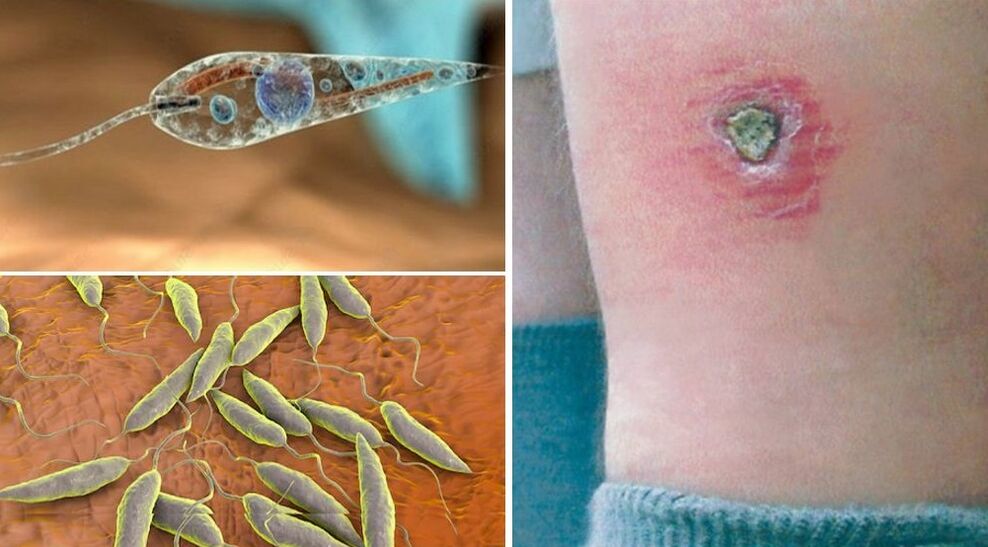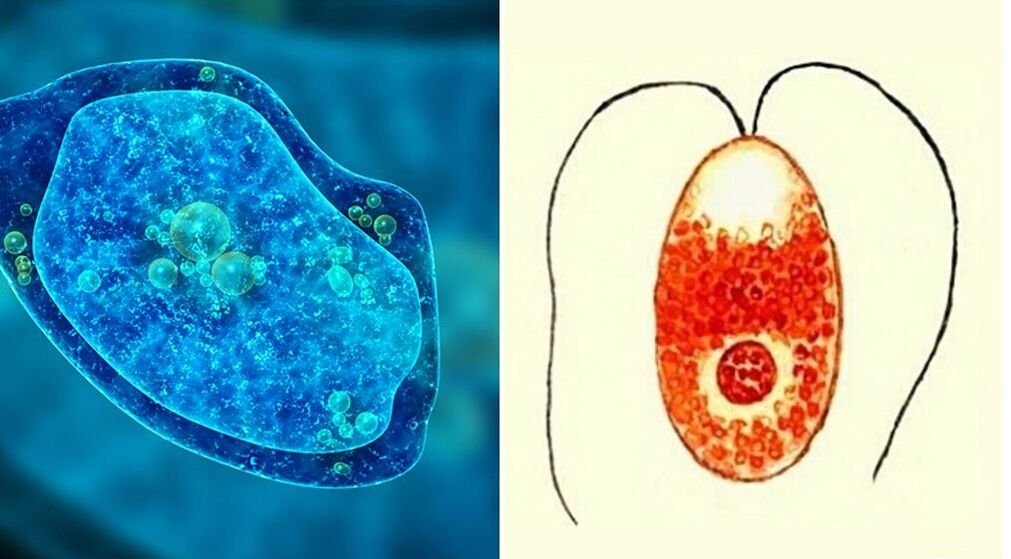Human protozoa are the causative agents of protozoa infections (or protozoa). These diseases are contagious, threatening complications and serious consequences. Therefore, genital warts should be diagnosed promptly, accurately identified the pathogen and treated properly.
What is a protozoan?
This is a group of single-celled microorganisms that are unable to produce nutrients independently. In the process of living, they use other organisms, causing them serious diseases. The most common human protozoan parasites are listed below:
- flagellates - giardia, leishmania, trichomonas, trypanosoma;
- ironic - amoebic dysentery;
- ciliates - bursaria, balantidia;
- sporozoans - malaria plasmodium, coccidia, piroplasms.
Trypanosoma
It is the simplest parasite whose life cycle takes place in an infected ungulate (antelope) or infected person. The carrier of the disease is the tse-tse fly, which, when bitten by a person, injects salivary protozoa into the person's skin.
On a note!
For the development of the disease (African trypanosomiasis or sleeping sickness), the introduction of about 400 trypanosomes is necessary. With one bite of a tse-tse fly, up to half a million individuals of the parasite fall.
Characteristics of parasites and diseases:
- trypanosomes initially circulate in the blood of the infected person, causing trypanids on the skin (swelling of the face, eyelids), fever with a temperature of up to 40 ° C, swollen lymph nodes;
- then protozoan parasites migrate into the cerebrospinal fluid, causing drowsiness, vasculitis, chronic fatigue, coma, impaired speech, coordination;
- Advanced forms of trypanosomiasis infection are marked by convulsions of the extremities, seizures, neurological and physical impairment, respiratory paralysis, coma, and death.
To diagnose trypanosomiasis, the Romanovsky-Giemsa test, immunofluorescence, enzyme immunoassay (ELISA), lymphadenectomy are used. Confirmation of the diagnosis is usually done by placing the patient's blood in a laboratory pig. Treatment of sleeping sickness involves taking special medications. In the absence of treatment with a high probability, the patient can die.
lamblia
Microscopic protozoa (synonym - giardia or giardia) with four pairs of flagella are cyclical parasites in the human body. Under certain conditions, they cause giardiasis. Giardia are attached to the wall of the small intestine by a large suction tube, which usually settles in the ducts of the liver, gallbladder, and other internal organs.
On a note!
Protozoa contamination occurs with food and water, under unsanitary conditions. Giardia cysts with embryos remain infiltrated in the environment for a long time (up to 3 months in fresh water, up to 4 months in wastewater). Diagnosis of protozoa is made by microscopy of cysts and adults in faeces, blood, and antibody detection in ELISA studies.
Leishmania
These flagellated protozoa cause leishmaniasis, a disease common in tropical and subtropical countries. Infection occurs by way of transmission - when bitten with the saliva of blood-sucking insects, animals (dogs, ground squirrels). Mosquitoes, mosquitoes, butterflies, ticks can be carriers of diseases. There are two types of leishmaniasis in humans:
- skin and mucosal forms (pendulum ulcers) - leishmania lives and multiplies in human skin, causing inflammation, swelling, ulcers, trophic ulcers, respiratory tract lesions;
- visceral form - leishmania settles in internal organs (spleen, liver, lungs, heart).
A characteristic sign of skin leishmaniasis is the formation of brown nodules (leishmaniomas) at the site of an insect sting. They are then replaced by round, hard-to-heal ulcers with purulent secretions. The disease lasts 1-2 years leaving scars on the skin. In its visceral form, leishmaniasis causes dysfunction of the adrenal glands, kidneys, liver, and spleen. When leishmania is diagnosed, they are found in the bone marrow, lymph nodes, skin scrapes, and blood.

On a note!
Treatment for leishmaniasis includes isolation measures, patient isolation, and medication.
Trichomonas
These are the simplest parasites of the human internal environment, transmitted sexually, through indoor contact or by mother-to-child transmission. There are genera of Trichomonas in the mouth, intestine and urogenital. Protozoa are the causative agents of trichomonas/trichomoniasis. Trichomonas infections of the genitourinary system are common. The chronic form of the disease threatens with impotence and persistent infertility. Parasitic characteristics of Trichomonas:
- body size - up to 18 microns, moves rapidly due to mobile flagella;
- drug resistance, determining the chronic course of trichomoniasis;
- die quickly in the environment, in the air, under direct sunlight;
- long stay on wet towels, sponges, towels, soap dishes;
- frequent infections during vaginal, oral-vaginal sex;
- Trichomonas contributes to the development of candidiasis, vulvovaginitis, chlamydia, gonorrhea, cystitis.
Diagnosis of Trichomonas infection involves the detection of Trichomonas in swabs from the genitals. Treatment using drugs, treatment with antiseptics. Therapy is administered in both partners to avoid recurrence. Prevention of urogenital trichomoniasis includes recommended measures for all sexually transmitted diseases.
amoeba dysentery
This ironic microorganism is a parasite that causes dangerous diseases in humans. There are two forms of amoebic dysentery - intestinal and gastrointestinal (liver or lung). The disease begins 7-10 days after infection with symptoms - bloody diarrhea, fever, vomiting.
If left untreated, the consequences of amoebiasis develop - dehydration, exhaustion, weakness, internal bleeding, liver abscess. Infection most commonly occurs via the fecal-oral route. Amoeba carriers can be insects - flies, flies. During the diagnosis, protozoa tissue forms are found in the feces. Treatment of amoebiasis is topical, with the use of antibiotics.

Malarial Plasmodium
Representatives of the simplest sporozoans, the causative agent of a dangerous disease - malaria. The human body acts as an incubator, where the life cycle of the parasite takes place. Features of Parasitism:
- plasmodium flagellar infection occurs when bitten by a malaria mosquito;
- flagellate enters the bloodstream with the saliva of an infected insect;
- sporocysts are deposited in the liver, penetrating its cells (hepatocytes);
- here merozoites are formed by mitotic replication;
- when liver cells are destroyed, merozoites enter red blood cells;
- from merozoites as a result of the sexual cycle, gametes are formed;
- mosquitoes are infected with gametes when bitten by an infected person;
- in the mosquito body, the gametocytes enter the egg cells and then into sporophytes;
- one mosquito infects a healthy person, and the cycle repeats.
The destruction of red blood cells and the release of gametes into the blood is accompanied by fever, vomiting, anemia, convulsions, and arthralgia. In severe cases, the risk of death increases. Malaria is usually of a relapsing nature with periods of exacerbation and remission. Different protozoa cause tropical malaria, three days and four days. The main therapeutic and diagnostic agent is quinine - natural from quinoa or synthetically.
Infusoria balantidia coli
This causative agent of balantidia (or blood-borne dysentery) lives in the large intestine, causing bleeding ulcers on the intestinal wall. Protozoa infection occurs from livestock, the main carrier of which is pigs. Features of anatomy and parasitology:
- The body of the Balantidia tree is ovoid with a thick, firm shell (pellicle);
- on the surface there are many cilia for movement;
- sexual form of the parasite necessary for reproduction by simple fission;
- asexual form (cyst) into the environment by feces;
- The route of infection of human cysts is oral - fecal.
The colonization of protozoa in the gut is accompanied by headache, vomiting, and dyspepsia. The acute stage of toxocariasis is manifested by fever, signs of severe intoxication, and bloody stools. In the absence of prompt treatment, it can lead to death.
Toxoplasma gondii
Microscopic crescent-shaped protozoa from the order Coccidia are widely distributed in the environment. They are the causative agents of the disease - toxoplasmosis. In healthy people, ingested insects will be destroyed by immune cells. Characteristics of diseases caused by protozoa in humans:
- often toxoplasmosis has no symptoms, after recovery will develop immunity;
- parasites affecting the organs of vision, reproductive system, nervous, lymphatic, liver, spleen;
- during pregnancy, toxoplasmosis causes serious congenital pathologies in the fetus or fetal death;
- progressive acute form with convulsions, paralysis, liver enlargement, heart problems;
- in a chronic process, dysfunction of the heart, damage to the organs of vision can occur.
The main host of the protozoa is the cat. In their bodies, giant Toxoplasma colonies are formed from ovarian follicles. Humans are intermediate hosts, and they are infected through ingestion, household contact, or the oral-fecal route.






































